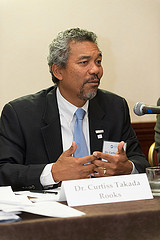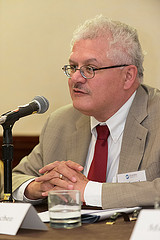Art and Imagination of the Short-Term Visit
“Art and Imagination of the Short-Term Visit” was one of ten panel discussions that was held on October 4, 2013, during the 4th USJC Annual Conference.
Panelists
Moderator: Dr. Curtiss Takada Rooks, Associate Dean of Bellarmine College of Liberal Arts, Loyola Marymount University
Speakers: Mr. Paul Niwa, Associate Professor, Emerson College
Dr. George J. Sanchez, Vice Dean for Diversity and Strategic Initiatives, Dornsife College of Letters, Arts & Sciences, University of Southern California
Ms. Ayumi Takita, Program Director, Intellectual Exchange, Japan Foundation Center for Global Partnership, New York
Description
This session explored innovative and imaginative approaches to engaging American students through short-term visit programs to Japan emphasizing academic and professional disciplines. The presenters highlighted successful programs, providing insights about their programs from idea to implementation. The session looked at how organizations outside the university are able to assist educators through grants or other support. Following the presentations and Q&A, the audience joined them in brainstorming innovative ideas beyond traditional approaches for expanding the use of education to strengthen U.S.-Japan relations.
Summary
Special thanks to moderator Dr. Curtiss Rooks for providing this summary!
Curtiss Takada Rooks led off the session with a challenge: to not view short-term visits as a challenge to traditional study semester/year study abroad programs. This is not an either/or choice but can be an either/and. The broad goal is to expand the use of educational programs in support of U.S.-Japan relations. To illustrate this approach, he introduced the topics to be covered by the panelists. Paul Niwa’s program used the academic discipline of journalism to recruit graduate students to his short-term program, in which Japan became the “place of investigation.” George Sanchez’s program focused on first-generation undergraduates, and there Japan became a “place of self-discovery” that allowed students to see themselves and their lives through the lens of Japan and its people. Ayumi Takita provided insights into funding sources and developing strong grant proposals.

Paul Niwa introduced his program in the context of the larger initiative to increase student exchange between the U.S. and Japan by citing the The U.S.-Japan Conference on Cultural and Educational Interchange (CULCON) Education Task Force Report issued this past summer. This report sets the goal of doubling the number of Japanese and Americans studying in each other’s country by 2020. By positioning his short-term program in the academic discipline of journalism, he was able to recruit nationally students who were interested in sharpening their disciplinary skills in Japan. Thus, the attraction was two-fold: first, skills improvement and second, an international experience in Japan. Mr. Niwa stressed not only journalistic academic rigor of the program, but also rigorous self-reflection of the experience and the specificity of Japan. Students challenged by both found themselves transformed, recognizing that they, too, as journalists played a role in global leadership. Finally, Mr. Niwa emphasized the need for good logistical planning, the importance of a strong relationship with the program officer and the inclusion of an openness and respect for difference as a criterion for acceptance into the program.
George Sanchez’s program targets first-generation undergraduates at the University of Southern California (USC), providing them a chance to understand themselves in an international context. Many of the program’s participants have never traveled abroad, nor have they traveled extensively within the United States, and a good number grew up within a 10-15 mile radius of the USC campus. His program is designed to assist students in providing a broadened context for understanding themselves and their life experiences. Grounded deeply in scholarly investigation, the students examine the ways in which Japan impacts their lives in the United States. In preparation for the short-time visit to Japan, students investigate and tour Japan corporations like Toyota, which are engaged not only in Los Angeles but also in neighborhoods along the Alameda corridor. In addition, students investigate U.S. corporations invested in Japan, like Disney. Students also research a topic within their home communities, such as homelessness, so that they can investigate and compare during their short-term visit how Japan approaches these topics.
An important feature of this comparative activity is that students must find a way to engage “everyday Japanese” people in their understanding of how that topic is approached in Japan. This part is challenging in that the USC students generally do not have Japanese language skills, but the students find a way to communicate. The USC program has proven to be transformative for the participants. Students gain not only an appreciation for Japan, but more importantly a deeper understanding of themselves. For many, the short-term visit allows them to see themselves in a new light as they embrace their own life experiences from a position of strength, rather than from one of shame. Seeing themselves through the eyes of the Japanese people they meet provides a radical reflection denied them in the United States. Following the program, students change majors, sometimes switching to political science and international relations, but also to American Studies, where they engage in a study of their own communities.
Ayumi Takita provided the audience with the background of why the Center for Global Partnerships (CGP) extended its outreach beyond traditional programs in which it expanded notions of intellectual exchange. Recognizing the need to introduce “new persons” to Japan, CGP embraced innovation and new ideas for engagement. Audience members were provided with grant opportunity materials. Ms. Takita also shared insight into grant reviews. She emphasized the need for applicants to read carefully the goals and requirements of the grants to ensure a good fit between the applicant’s idea and the specific grant. She also noted that successful grant applications followed the application process carefully and completely, providing all needed documentation. Once receiving the grant, developing a strong relationship with the program officer is perhaps the most important tip. The program officer can assist faculty members in thinking through the logistical planning of the visit and offer ideas and assistance for activities in Japan.

The general discussion following the presentation yielded at least three important discoveries. First, there were several other programs and agencies that offer grant funding for short-term visits to Japan. These representatives echoed the need for good planning and relationships, but were really interested in the transformative outcomes of such short-term opportunities. The second discovery was that audience members are engaged in planning short-term visits. Primarily, this group sought advice on logistics and assessment. Regarding assessment, the panelists unanimously encouraged developing some baseline measure prior to the visit that could be post-tested following the time in Japan. The third discovery was that planning and logistics matter when traveling abroad. Here, the assistance of and relationship with the program officer, granting organization and other organizations such as the Japan Foundation are imperative.
Curtiss Takada Rooks summarized the presentations, discussion, questions and answers, resulting in two salient observations. First, the featured short-term visit programs created transformative experiences for students, introducing to them the idea of being global leaders through a stronger understanding of themselves. The person-to-person exchanges between the participants and the Japanese people they met on their visit provided extraordinary opportunities for the students to see themselves in a different light, prompting a new understanding of themselves and their relationship to the broader world. Not only was there introspection, but also the cultivation of relationships with individual Japanese citizens. Engagement for the students went beyond personal interaction, reaching Japan, its culture, political economy, sense of “peopleness” and sheer physical beauty. Their presence in Japan – the sights, sounds, smells, touch and people – provided the context for their expanded self-understanding.
Second, the short-term visit programs were academically rigorous, grounded in sound theory and method. Students acquired and refined skills within and across their disciplines. Each program required scholarship of its students, as well as reflection, grounded in the critical analysis of an academic topic, self and Japan, the place and its people.